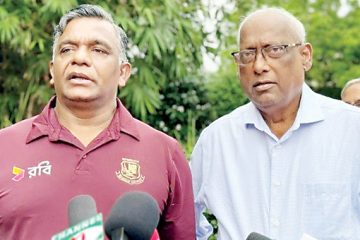In John Wright’s popular book “Indian Summers”, he mentions on many occasions how difficult it is for coaches when all is said and done and the team is out in the middle.
During the second innings of the decisive 5th one-dayer against Pakistan in 2003-04, Wright wrote: “After all the practice, planning, fielding charts, computer analysis and the team talks, you’re reduced to hoping like hell the other mob has an off day. I tried to stay as detached as possible, knowing there was nothing I could do.”
Wright had Sachin Tendulkar, Sourav Ganguly, Rahul Dravid, Virender Sehwag, VVS Laxman and Anil Kumble in his corner. Despite the presence of such luminaries, Wright had little or no control over the events in the cricket field. It is even more difficult for a coach who is in charge of mere mortals and that is exactly what makes Jamie Siddons’s stint as Bangladesh coach remarkable.
If his three-year reign as Bangladesh coach is analysed, it would be the win-loss record that comes up first. His one reads 111-33-77-1 (in Tests, ODIs and T20s) including a historic one-day series win over New Zealand, first wins over England, a total of seven one-day series wins and one Test series win over West Indies. Given the time he took over and what he had to face less than a year into office, it is indeed noteworthy.
Apart from these 33 wins though, Siddons has made an important contribution to Bangladesh cricket at large. He has developed a batting line-up that can be considered part of the armoury rather than a liability. The Tigers now have a number of batsmen who have become of international standard. Tamim Iqbal and Shakib Al Hasan certainly top that list with Imrul Kayes and Mahmudullah Riyad now becoming important members of the national team. Zunaed Siddiqui and Rokibul Hasan too did well till late 2010 while Mushfiqur Rahim still shows patches of form. Shahriar Nafees’s resurgence also shows how important it is to play well in international cricket rather than just representing the country.
Siddons instilled the ethos of hard work and patience into players who came into the national team as half-baked cricketers. Their development has been excellent to watch but so was the tapering off of some after the Zimbabwe series. It showed how fickle international cricket can be, the moment you take your eye off the ball, results drop and runs dry up.
Many say that Siddons’s predecessor Dav Whatmore had tremendous man-management skills, an ability that he required with the experienced players and some of the temperamental ones. Siddons though seemed phlegmatic and less headstrong, giving him varied levels of success.
Mohammad Ashraful’s downfall in international cricket is sometimes looked upon as a flaw in Siddons’s time as the Tigers coach. When he wanted to create ‘many Ashrafuls’ in his early days, some say that he alienated the talented batsman. Some have also pointed out that the ‘team rules’ straitjacketed Ashraful’s strokeplay, the ex-captain famously playing out a maiden over in the opening match of the Kitply Cup just to adhere to that.
But Siddons has helped tremendously in the development of a number of cricketers in the team, particularly someone like Imrul who was considered a “strokeless wonder”.
Imrul’s improvement is certainly a testament of the youngster’s hard work and dedication but it is Siddons’s ethos that has helped him develop into an opener of international standard.
Sometimes in Bangladesh matches, an eye on the glass door at the Sher-e-Bangla National Stadium’s home dressing room would have showed Siddons constantly coming out near the rope than the others, especially when the Tigers are batting.
It may sound strange but most of the batsmen in the Bangladesh team needed their coach’s presence to guide them through torrid starts, their 40s and sometimes the 90s. Siddons, more often than not, used to gesture to calm down hot heads and it is said by those close to this team, the Australian succeeded in doing so.
In that regard, Siddons has left behind a huge void to fill. In fact, when a coach leaves these shores, we tend to look for what they have left behind. Some, in the past, have left scars while others have given some joy.
So what has Siddons left as his lasting legacy? Definitely the improvement and some consistency among the batsmen is one and it will also be the connection the players felt with him.
While the public would remember his term for the 4-0 whitewash, the groundbreaking series win in West Indies or the back-from-the-dead win over England in the World Cup, many of the players will miss his reassuring presence outside those glassed walls.
Courtesy of The Daily Star




















